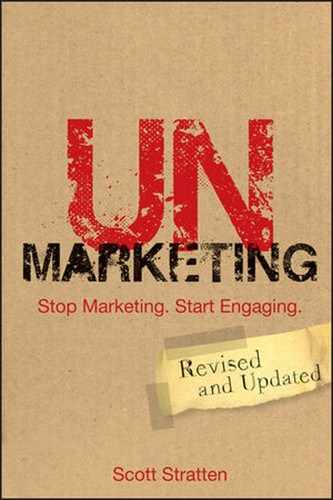10
Twitter versus Facebook versus LinkedIn
SO I’VE CONVINCED you to give it a try. The problem, or the great thing—depending on how you look at it—is that there are many options for where and how to start building your social currency.
How do you choose where to start? The main players in social networking for business are currently Facebook, Twitter, and LinkedIn. They all have their pros and cons and can all be beneficial for your business, depending on your market and needs. Here is a little bit of information about each one.
Facebook is the biggest of the three social media sites we are going to discuss. It was originally started as a U.S. college-based networking site and now has more than 400 million active users,25 with 70 percent of them being outside of the United States.
Common Terms:
Friend - The name for the people you connected with.
Wall - The hub of your activity, where people can read, post, and comment.
Tag - Connecting pictures, articles, and videos to specific friends who appear.
Poke-A virtual poke in the shoulder to say hi. Never, ever do this to people. It’s not only awkward, I am not sure that “poking” people is something you want to associate with your brand.
The Good:
Facebook not only has a high number of users, over half of them login every day.
Ability to create fan/business pages and groups. This allows companies to have a hub within a community that is already established.
One of the great things about the newest version of Facebook 26 is that it rewards you for engagement with your followers. This is called presumed relevancy27 where Facebook chooses what appears in your stream based on what you and your friends have commented on and/or liked. So the goal on Facebook is no longer just quantity of fans for your page, but frequent, relevant posts and updates that engage those fans.
The Bad:
Have to get approval to connect with someone by adding that person as a friend. On Facebook, when you want to connect with someone, you send that person a friend request. Before you can engage with the friend, the person has to accept that request. Vice versa, you will get requests from other people and decide if you want to be their friend. I do not like that you need to get someone’s permission to learn from them.
Apps and notifications can get really annoying to many (Farmville, MafiaWars invites). We talk more about some of these apps in the next section of the book when we discuss social media sins.28
LinkedIn is a strictly professional networking web site. It has more than 45 million users as of 2009. Wikipedia describes the purpose of the site “to allow registered users to maintain a list of contact details of people they know and trust in business.”
Common Terms:
Connections - The people on the list are called Connections. Users can invite anyone (whether a site user or not) to become a connection.
Recommendations - The ability to give testimonials for specific job roles on your profile from others.
The Good:
With only business users, the focus is more tightly on business networking.
Gives a great amount of business information for each person.
The Bad:
Sending a request to contact someone must go through potentially multiple gatekeepers.
Groups have great potential, but are mostly full of self-serving articles and sales pitches.
There are 25 million to 100 million users, depending on whom you ask. Use only 140 characters at a time.
Common Terms:
Tweet - The name of the message you send out, 140 characters or less.
Follower-A person who had chosen to read your tweets on an ongoing basis.
Retweet - The act of repeating what someone else has tweeted so that your followers can see it.
Hashtag - Start with the symbol “#”. It is a theme for the tweet that allows all similar tweets to be searched.
The Good:
Immediate conversations and connections.
No apps or groups, just conversation.
No barrier to engage in relationships.
The Bad:
A tweet has very little “shelf-life.”
High dropout of new users. It can take a little bit for users to “get” Twitter and often they stop using the site before they figure out how it works.
It’s the “no barrier” to communication from Twitter that really sold me. Since both LinkedIn and Facebook are permission-first sites, I need to “know” you before getting to know you, which makes no sense when you’re trying to meet other business owners. I use Facebook and LinkedIn as secondary levels. Once I’ve gotten to know someone on Twitter, we can go to the next level on either of those two sites because I now “know” them.
..................Content has been hidden....................
You can't read the all page of ebook, please click here login for view all page.
